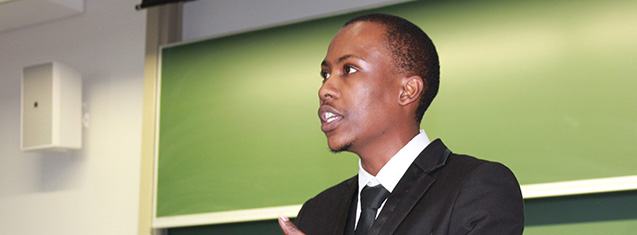
Photo: Nkahiseng Ralepeli debates his way to the finals of the English as a First Language category at the UCT Open.
Team UFS flexes its debating muscles
Friday 24 July 2015 marks the day when the University of the Free State Debating Society (UFDS) outperformed the University of Cape Town (UCT) at the UCT 150th anniversary celebration of its debating union.
Representing Kovsies were Zola Valashiya, Ntsapi ‘Neko, Nkahiseng Ralepeli, Lehakoe Masedi, and Thabang Thembani, who fought bravely for a spot in the finals.
Masedi and Ralepeli broke into the semifinals after seven preliminary rounds, eventually winning the competition. The two students were up against three UCT teams, comprising the current National Champions and Pan African finalists.
This follows the debaters’ outstanding performance at the 2015 South African National University Debating Championship (SANUDC), hosted by the University of Venda. The UFDS commemorated a decade in existence by participating in its 10th national tournament.
After nine preliminary rounds, two teams broke into the grand finals of the two categories: English as a second language (ESL) and English as a first language (EFL). Devon Watson and Nkahiseng Ralepeli were the EFL team who fought their way through to the finals, beating UCT and the University of Botswana.
The inaugural Wits Women’s Debate Open (2014) title holders, Lerato Leteane and Lehakoe Masedi, represented Kovsies as the ESL finalists against the University of Nambia. The ladies rose to the occasion, but eventually emerged just one point short of the Namibian team’s four-point win.
Nonetheless, they were satisfied with their competitive skills, utilising the platform to address the lack of female debaters in the Southern African debating circuit.